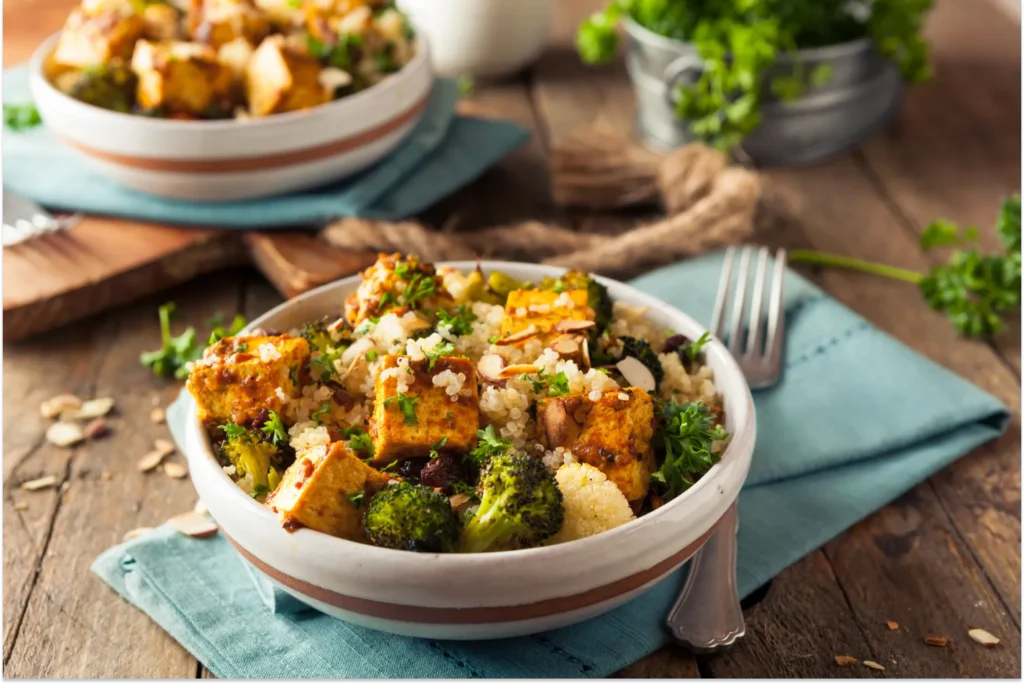In the bustling arena of modern cuisine, vegan bowls have emerged as a front-runner. They are beloved for their versatility, combining flavors and whole-food ingredients to offer nutritious value and sheer convenience.
Whether it’s the comforting ease of grain bowls on a weeknight, the exotic allure of Buddha bowls, the hearty depth of burrito bowls, or the vibrant freshness of noodle and rice bowls — there’s a vegan bowl waiting to cater to every palate and preference.
Step-by-Step Guide: Creating Four Different Vegan Bowls
Reflecting several cuisines, vegan bowls effortlessly bridge the gap between health and taste. While the prep time is surprisingly minimal, the outcome is always a meal brimming with nutrition and flavor.
Using the bowl as a base, vegan bowls can help you explore different cultures through cuisine. By varying the ingredients, you can make a Moroccan bowl with couscous and turmeric or an Asian-inspired bowl with noodles and edamame and experience the joy of different cultures without leaving home.
Vegan Buddha Bowl
A staple in the realm of vegan bowl recipes, the Vegan Buddha Bowl is both fulfilling and visually appealing. The foundation of this bowl is lettuce chopped into bite-size pieces.
Once your lettuce is in the bowl, pile on roasted sweet potatoes for a dash of sweetness and edamame and red onions for added nutrition. Swirl in a tahini sauce enriched with a squeeze of lemon and a dash of garlic. Garnish with leafy greens, crispychickpeas, and perhaps a crumble of falafel, making every bite fresh and delightful.
Vegan Burrito Bowl
Swap your usual tacos for this hearty bowl during your weeknightdinner recipe exploration. To make a Vegan Burrito Bowl, you can start with a generous portion of brown rice layered with arugula and protein-rich black beans.
Roasted red onions, bell peppers, and jalapeño peppers elevate the texture and taste. From there, add diced tomato and avocado to give your bowl a fresh twist.
The star, however, is a chipotle dressing, bursting with smoky flavors. Top your bowl with a sprinkle of cilantro or your favorite topping for that perfect finish.
Vegan Power Bowl
The Vegan Power Bowl embodies strength, nutrition, and explosive flavor. Start with a base of cooked lentils. Grains like farro or quinoa add a lovely chewy texture to any dish and pack it with carbohydrates.
Once you have your lentils in the bowl, top with roasted veggies such as broccoli and cauliflower, which are both packed with important vitamins and nutrients. Sprinkle beets over your roasted veggies, and swirl in a generous serving of hummus, delivering a creamy, rich texture that complements the other ingredients.
To make this bowl even more flavorful, add a drizzle of tangy peanut dressing that features peanut butter, vinegar, soy sauce, garlic, red pepper flakes, and sesame oil. This sauce binds the bowl’s components together, giving it a nutty and zesty finish.
Add a handful of leafy greens for freshness, perhaps some thinly sliced radishes for crunch, and a sprinkle of sesame seeds for added flair.
Vegan Poke Bowl
A traditional favorite hailing from the Hawaiian islands, the Poke Bowl has become a global sensation, and this vegan twist on the classic doesn’t fall short on authenticity or taste. Instead of the conventional fish, this version uses tofu as its star, ensuring a light yet protein-rich experience.
Begin with a base of either Basmati rice, ensuring a filling, whole grain foundation. Cube your tofu and saute it in a pan with olive oil until it is browned. Now, it’s all about layering and textures. Pack your bowl with edamame beans, introducing a delightful crunch and plant-based protein kick.
From there, you can add cubed avocado and thinly sliced carrots and radishes to the top. Sprinkle with sesame seeds for added texture, and drizzle miso dressing on top. The miso dressing offers a rich, umami flavor and combines miso, sesame oil, rice vinegar, soy sauce, sugar, and freshly grated ginger whisked together.
Are Vegan Bowls Healthy?
When considering a nourishing and delicious diet, many are turning toward vegan bowls. These meals come packed with a powerhouse of nutrients, but the question on everyone’s mind is: Are vegan bowls truly healthy?
At the heart of a vegan bowl, we find whole grains like quinoa, farro, or brown rice. These grains are not just filling but are also great sources of healthy carbohydrates and dietary fiber. Whole grains have been associated with various health benefits, from supporting heart health to maintaining healthy digestion.
Vegan bowls are also packed with plant-based protein sources. For instance, a Vegan Buddha Bowl might feature roasted chickpeas or tempeh, providing a hearty protein punch.
Lentils, black beans, and edamame are other popular protein-packed choices. These plant-based proteins, apart from being excellent sources of amino acids, provide several essential vitamins, minerals, and fibers without the saturated fats found in animal proteins.
Veggies are the stars in these bowls, adding splashes of color and bursts of flavor. Whether it’s the sweet earthy addition of roasted sweet potato, the tangy bite of red cabbage, or the fresh crunch of sautéedBrussels sprouts, there’s no denying the myriad of nutritious benefits they offer. The veggies found in vegan bowls are rich in essential vitamins, minerals, and antioxidants.
Certain ingredients add unique nutritional advantages Depending on the type of vegan bowls you prefer. For example:
- Turmeric in a Moroccan-inspired bowl is known for supporting immune health.
- Sesame seeds sprinkled atop a Vegan Poke Bowl provide calcium and magnesium.
- Tahini sauce, often drizzled over roasted chickpeas in a Vegan Buddha Bowl recipe, is a good source of healthy fats and amino acids.
Tips and Tricks for the Perfect Vegan Bowl
Achieving the perfect vegan bowl involves balancing flavors, textures, and ingredients. Here’s a guide to crafting that impeccable vegan bowl.
- Flavor Balance With Sauces: While the bowl components are crucial, the real stars can often be the sauces. While Tahini dressing adds a creamy, nutty undertone, pesto brings in a rich herby punch, and a miso-based sauce can add umami depth. Ensure you balance tangy, sweet, spicy, and savory when crafting your sauce.
- Varying Textures: Aim for a mix of textures. Crispyfalafel, crunchy sautéedveggies, or the softness of sweet potato are all different textures you can feature in your bowl.
- Efficient Meal Prep: One of the many advantages of vegan bowls is their suitability for meal prep. Components like roasted cauliflower can be prepared ahead of time. This cuts down the total time spent in the kitchen during those busy weeknights.
- Cook in Batches: Grains such as couscous, quinoa, or farro can be cooked in larger quantities and stored. This ensures you have a base ready for a vegan burrito bowl, noodle bowl, or any other vegan meal.
- Embrace the Rainbow: Different colored veggies often offer varying health benefits. Red onion, for example, is rich in antioxidants, while leafy greens provide iron and calcium.
Wrapping Things Up
Embracing the beauty and health benefits of vegan bowls can be both a journey and an art form. With their harmonious blend of flavors, textures, and nutritious ingredients, they serve as a wholesome meal option.
And if you’re looking to relish a Mediterranean-inspired bowl without the hassle of preparation, Luna Grill offers a delightful variety. Try our Vegan Bowl, thoughtfully crafted to make you feel good after eating.
So, whether you’re whipping up a bowl at home or seeking a memorable meal with family and friends, remember to cherish the moments and savor each bite. Visit Luna Grill today and make our kitchen yours.
Sources:
Mayo Clinic Minute: Discover the health benefits of farro | Mayo Clinic



